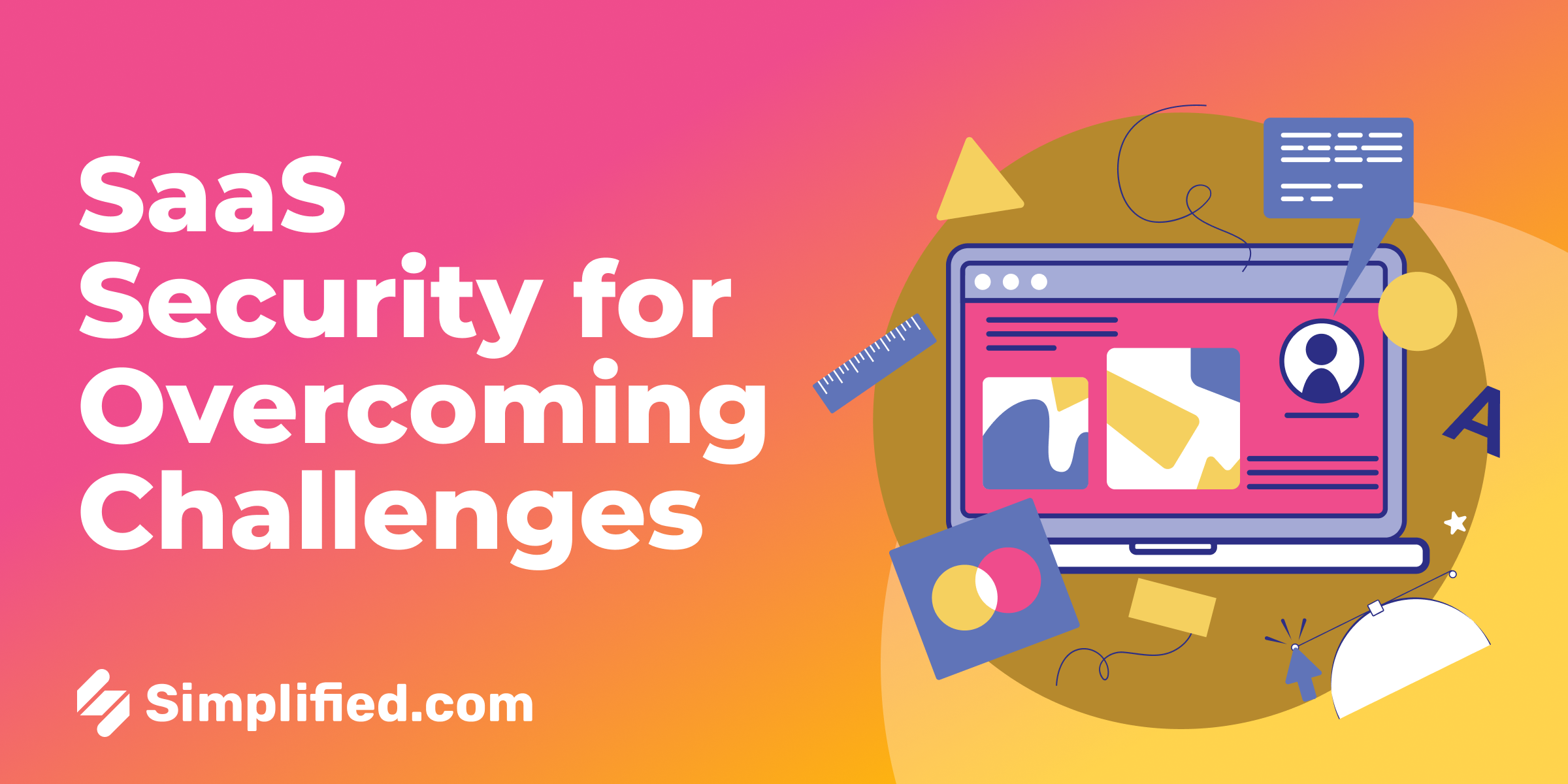
Businesses are increasingly adopting SaaS solutions to optimize workflows. Here is the snag: grasping even the most basic SaaS security basics can take time and effort.
According to this 2024 State of SaaS report, 96.7% of organizations experienced at least one app-related security incident in the past year. And four out of five organizations had at least one single-user app compromised.
The stakes cannot be higher.
We created this guide to explain the key challenges associated with SaaS application security. In addition, we provide seven practical best practices for protecting your SaaS application from common threats. Keep reading!
What Is SaaS Security?
SaaS security is important because it helps avoid severe consequences that can range from reputation damage to legal liabilities and loss of customers. It also helps ensure compliance with security standards and regulations, among other benefits. So, what is SaaS security?
Quite simply, SaaS security is the measures and processes that you implement to protect applications and data hosted by your SaaS provider. These measures can range from access controls, authentication, data backup and recovery, and the use of SSL/TSL certificates to ensure encryption. For enhanced protection, you can buy an SSL certificate to secure your SaaS platform and safeguard sensitive information from potential threats.
Why You Should Prioritize SaaS Security
Prioritizing SaaS security is crucial because these applications, integral to various organizational functions, often pose significant management challenges. SaaS apps serve diverse teams, from sales to HR.
This often leads to complex usage patterns that security teams need help to monitor. What’s more, limited communication between security and business administrators hampers threat understanding, while a focus on functionality over security risks leaves vulnerabilities. So, it would help if you prioritized SaaS security to mitigate potential breaches and ensure comprehensive protection.
Bonus: Scaling a Cybersecurity Content Marketing Agency
What are the Challenges Associated with Security in SaaS?
Five critical SaaS security challenges are associated with security in SaaS. These challenges are misconfiguration, fragmented applications and systems, varying user accesses and environments, and insecure API.
- Misconfigurations: This is one of the key SaaS security challenges, as it accounts for up to 63% of security incidents. Improperly configured SaaS applications create vulnerabilities that threat actors can easily exploit. These misconfigurations can be due to several factors. To further ensure the security of your SaaS applications and data, implementing comprehensive cloud data security measures is essential to protect against breaches and unauthorized access. However, the most notable ones include human error and an inadequate understanding of security settings.
- Disintegrated Applications: SaaS ecosystems are often made up of multiple applications and services sourced from different vendors. This disintegration complicates the implementation and maintenance of unified security approaches. As a result, this often opens up risk profiles in defense and needs help keeping an eye on threats on all the platforms.
- Data Breaches: The fallout can be massive when sensitive data falls into the wrong hands. It may not only include financial losses. It can also result in legal consequences and severe damage to your company’s reputation.
- Varying Use Access and Environments: SaaS environments allow users to access applications not just from different devices but also from varied locations at any time. It is challenging to balance user productivity and secure access as the IT security teams must find a way of managing the ever-changing permissions, user roles and authentication needs without breaching security measures.
- Insecure APIs: APIs are essential for integrating SaaS applications with other systems. What if APIs are not secure? The answer is simple but scary! These APIs can become the new entry points for attackers.
How can I improve my SaaS Security
When you entrust sensitive data to external SaaS vendors, you expose yourself to risks beyond immediate security considerations. To effectively safeguard data and maintain a solid security posture, consider incorporating Zero Trust Architecture (ZTA) as part of your SaaS security strategy to improve your SaaS application security. Here are seven SaaS security best practices to enhance your cloud security:
1. Improve Your Authentication
Cloud providers offer various methods for handling authentication. This variety can complicate user access to SaaS resources.
To streamline authentication,
- Integrate identity providers like Active Directory (AD) with Security Assertion Markup Language (SAML), OpenID Connect, and OAuth.
- Where supported, use single sign-on (SSO) tied to AD to ensure consistent account and password policies across SaaS applications.
- Enable Multi-factor authentication (MFA) to secure user access further.
2. Deal Thorough Mistakes and Scrutinizing
Carefully review and assess possible SaaS providers to comprehend their cloud security models and security features. Assess how the service is used and ensure it aligns with your organization’s security requirements.
During this process, pay attention to understanding each SaaS provider’s security features and potential vulnerabilities. To further strengthen your security posture, consider training your IT team using resources like cisco exam dumps to ensure they are well-equipped with the knowledge needed to address potential threats. This will help in informed decision-making and help you select providers that offer robust security measures.
3. Implement CASB Tools
Cloud Access Security Broker (CASB) solutions can save you when a SaaS provider’s cloud security is insufficient. CASBs add controls that SaaS providers do not natively support.
They also offer various deployment modes (API or proxy-based) that can be tailored to fit your organization’s architecture. And since they address cloud security gaps, CASBs provide an additional layer of protection.
This could be all you need to ensure compliance and mitigate risks associated with SaaS applications. Use CASB tools to maintain control over data security and access management to improve your organization’s security posture.
Bonus: How AI is Transforming Design & The Importance of Data Security for Creatives
4. Use SaaS Security Posture Management (SSPM)
Superior SSPM tools are designed to monitor SaaS applications continuously. This way, they can identify and address application security gaps and misconfigurations in real-time.
These tools automatically prioritize risks based on severity to allow for timely remediation. SSPM solutions help prevent compromises and enhance the overall security of SaaS environments. They achieve this by ensuring that SaaS applications are properly configured and aligned with security policies.
5. Ensure Robust Data Encryption
Data encryption is critical for protecting information transmitted to and from SaaS applications. Transport Layer Security (TLS), which you can implement with a valid SSL/TLS certificate, secures data in transit.
However, some SaaS providers offer encryption for data at rest. So, invest time in researching each service’s cloud security measures.
Also, where available, be sure to enable encryption features. As you probably already understand, enabling encryption will help ensure that sensitive data remains protected against unauthorized access and breaches.
6. Maintain Comprehensive Discovery and Inventory
With SaaS, unexpected usage patterns are common. This is particularly true with rapid application deployments.
Therefore, you will want to track all SaaS usage continually. Combine manual data collection with automation tools to maintain an up-to-date inventory of SaaS services and users. For example, using data scraping tool can enhance this process by automating the extraction of usage data, identifying trends, and ensuring accurate records for better SaaS management.
7. Increase Situational Awareness
Don’t leave anything to chance. Monitor your SaaS usage and analyze data and logs provided by SaaS providers.
You can use tools like CASBs for this purpose. Your IT and security executives must treat SaaS offerings with the similar security as enterprise applications offer.
It will also help to implement systematic risk management measures to ensure safe SaaS usage and protect your organization’s data. Regularly monitor and perform risk assessments to promptly identify potential threats and vulnerabilities.
Conclusion
For starters, improving a SaaS application security landscape can seem intimidating. Interestingly, it is easy if you know what to look at. Begin by implementing the practical strategies outlined in this guide to significantly enhance your SaaS security, safeguard sensitive information, and lessen risks related with SaaS.












